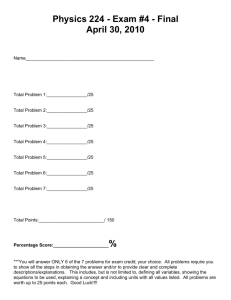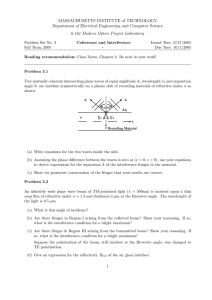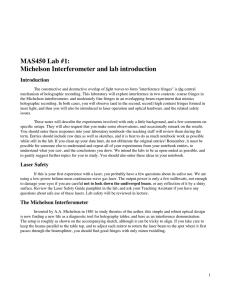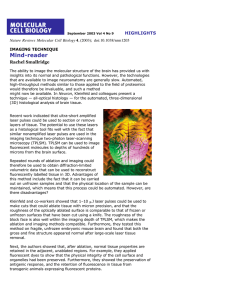vii ii iv
advertisement
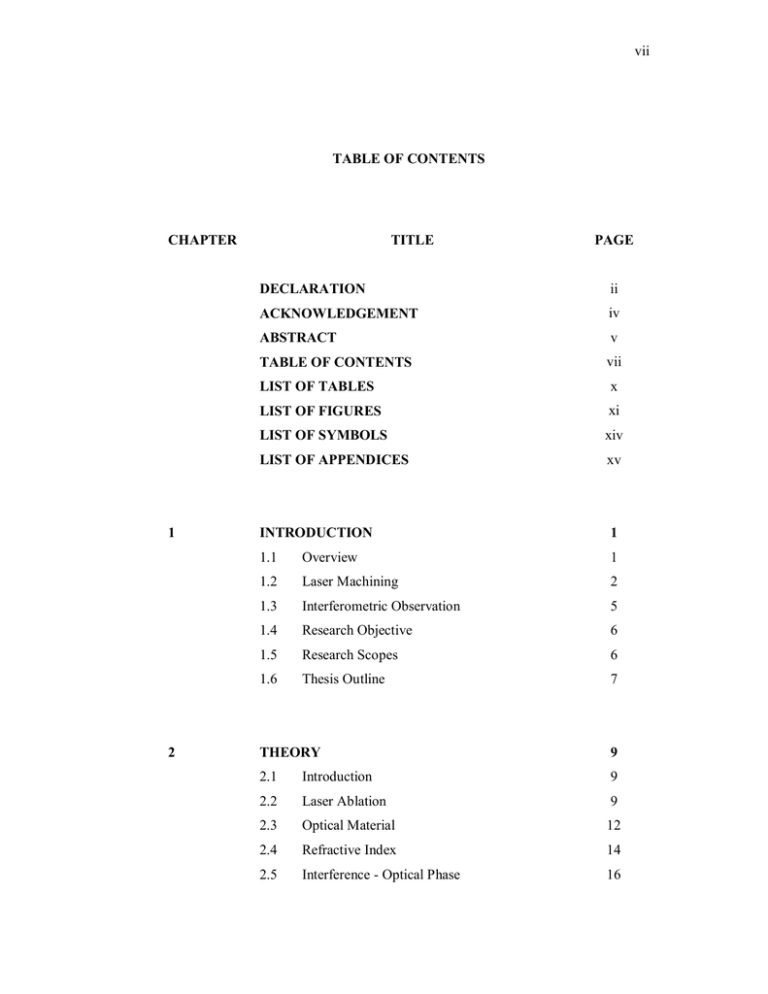
vii TABLE OF CONTENTS CHAPTER 1 2 TITLE PAGE DECLARATION ii ACKNOWLEDGEMENT iv ABSTRACT v TABLE OF CONTENTS vii LIST OF TABLES x LIST OF FIGURES xi LIST OF SYMBOLS xiv LIST OF APPENDICES xv INTRODUCTION 1 1.1 Overview 1 1.2 Laser Machining 2 1.3 Interferometric Observation 5 1.4 Research Objective 6 1.5 Research Scopes 6 1.6 Thesis Outline 7 THEORY 9 2.1 Introduction 9 2.2 Laser Ablation 9 2.3 Optical Material 12 2.4 Refractive Index 14 2.5 Interference - Optical Phase 16 viii 2.6 3 21 METHODOLOGY AND MATERIAL 22 3.1 Introduction 22 3.2 Excimer Laser System 22 3.2.1 Internal Structure 23 3.2.2 External Triggering 25 3.3 Energy Measurement 26 3.4 Beam Profile 28 3.5 Sample Preparation 30 3.6 Interferometer 31 3.6.1 Magnification 34 3.6.2 Fringes Analysis 36 3.7 4 Summary Summary 37 CHARACTERIZATION OF EXCIMER LASER BEAM 39 4.1 Introduction 39 4.2 Energy and Peak Power 39 4.2.1 Pumping Energy 40 4.2.2 Number of Pulses 42 4.3 Excimer Laser Beam Profile 4.3.1 Beam Profile at Various Discharged Voltage 4.3.2 43 45 Beam Profile at Various Working Distance 48 4.4 Energy Per Unit Area 51 4.5 Summary 52 ix 5 DIAGNOSE THE ABLATION EFFECT BY INTERFEROMETRY METHOD 54 5.1 Introduction 54 5.2 Reference Fringes 55 5.3 Ablation Threshold 57 5.4 Ablation Effect 59 5.4.1 Shifted Fringes 63 5.4.2 The Changes in Fringes Intensity 67 5.4.3 Fringes Spacing 71 5.5 6 7 76 DETERMINATION OF ABLATION DEPTH 78 6.1 Introduction 78 6.2 Brewster Technique 79 6.3 Refractive Index Changes 80 6.4 Ablation Depth 85 6.6 Summary 93 CONCLUSIONS AND SUGGESTION 94 7.1 Conclusions 94 7.2 Problems and Suggestions 97 REFERENCES PUBLICATIONS APPENDIX Summary x LIST OF TABLES TABLE NO. 4.1 TITLE PAGE Single pulse energy and peak power of the beam upon discharged voltage 40 Pulse energy and peak power of the laser beam at different number of pulses 42 4.3 Area of intensity distribution upon discharged voltages 47 4.4 Area of intensity distribution upon working distance 50 4.5 Energy per unit area 51 5.1 Data of shifted distance for all tested fringes (F1 to F7) 64 5.2 Data of fringes intensity for all tested fringes (F1 to F7) 67 5.3 Data of intensity changes for all tested fringes (F1 to F7) 68 5.4 Data of fringes spacing for all tested fringes (F1 to F7) 72 5.5 The flatness for all tested fringes (F1 to F7) in term of ë/2 73 6.1 Power at different angle on the exposed material 81 6.2 Refractive index of the exposed material 84 6.3 Results of calculated depth, d for 10, 12, and 14 pulses exposures 88 Results of calculated depth, d for 16, 18, and 20 pulses exposures 89 4.2 6.4 xi LIST OF FIGURES FIGURE NO. TITLE PAGE 2.1 Hypothetical steps in the interaction of a laser beam with a polymer surface (Srinivasan, 1993) 11 2.2 Structure of polymethyl methacrylate 12 2.3 Schematic of a UV-treatment system (Garbassi et al., 1998) 13 A wave reflecting and refracting at an interfaced (Hecht & Zajac, 1989) 15 2.4 2.5 Interference produced by division wavefront (Parker, 1988) (a) Young’s two-pinhole interferometer (b) Lloyd’s mirror 17 2.6 Interference produced by division of amplitude (Parker, 1988) 18 2.7 Formation of fringes of equal inclination by reflection in a plane-parallel plate (Hariharan, 1985) 18 3.1 An electrical discharge exciting a gas laser (Hecht, 1992) 3.2 Internal energy of R-H molecule in excited and ground state (Hecht, 1992) 24 3.3 An excimer laser connected to a function generator for external triggering 25 3.4 Ophir Optronics energy meter and its display 27 3.5 Experimental set up for excimer laser beam calibration 27 3.6 CCD camera Beamstar Profiler and its software 28 3.7 Option screen for Beamstar CCD laser beam profiler 29 3.8 Option windows for beam size measurement 30 23 xii 3.9 Schematic diagram of sample for ablation work 3.10 Schematic diagram of interferometer setup over excimer laser system 33 3.11 Option windows for ruler calibration 35 3.12 Option windows for calibration set-up 36 4.1 Pulse energy of the beam versus discharged voltage 41 4.2 Pulse energy of the laser pulse versus number of pulses 43 4.3 Beam profiles of ArF excimer laser in 3D view 44 4.4 Beam profiles of ArF excimer laser in top view (2D) (Magnification 15X) 44 4.5 Beam profiles at various discharged voltages of the ArF excimer laser (Magnification 15X) 46 4.6 The laser spot area versus discharged voltage 48 4.7 Beam spot at various working distance of the ArF excimer laser (Magnification of 15X) 49 The laser spot area versus working distance. Laser operated at discharged voltage of 12 kV with repetition rate of 20 Hz 50 4.9 Energy per unit area versus number of laser pulses 52 5.1 The image of reference interference pattern (Magnification 2.5X) 55 The ‘option windows’ of Matrox Inspector software 56 The fringes pattern of PMMA and its spectrum profile before ablation 57 5.4 Fringes profile at threshold energy 59 5.5 Ablation interferograms and their line profiles after exposed by (a) 10 pulses (b) 12 pulses (c) 14 pulses 61 5.6 Ablation interferograms and their line profiles after exposed by (a) 16 pulses (b) 18 pulses (c) 20pulses 62 5.7 Graph shifted distance of fringes upon number of pulses 4.8 5.2 5.3 31 66 xiii 5.8 Graph intensity changes upon fringes for 12, 14, and 16 pulses exposures 69 Graph intensity changes upon fringes for 18 and 20 pulses exposures 70 5.10 Option windows for spacing measurement 72 5.11 Histogram of flatness upon fringes after exposed with 10, 12, and 14 pulses 74 5.12 Histogram of flatness upon fringes after exposed with 16, 18, and 20 pulses 75 5.9 6.1 Schematic diagram of Brewster’s angle measurement 80 6.2 Power of the laser beam versus incidence angle for 10, 12, and 14 pulses exposures 82 6.3 Power of the laser beam versus incidence angle for 16, 18, and 20 pulses exposures 83 6.4 Refractive index versus number of pulses 85 6.5 The example of fringe pattern shifts by an amount of ∆x (Pedrotti and Pedrotti, 1993) 86 6.6 Histogram of ablation depth upon fringes after 10, 12, and 14 pulses 90 6.7 Histogram of ablation depth upon fringes after 16, 18, and 20 pulses 91 6.8 Depthness as a function of number of pulses 92 xiv LIST OF SYMBOLS A - Area of high intensity distribution [A] - Amplitude of wave c - Speed of light in vacuum d - Ablation depth E - Pulse energy [E]|| - Light with electric vector [Er]|| - Reflected light [Et]|| - Transmitted light F - Flatness I - Intensity L - Working distance m - Integer M - Order of interference N - Number of pulses n - Refractive index P - Power ∆p - Optical path difference t - Thickness ∆t - Changes thickness V - Discharged voltage W - Normal spacing (before exposure) w - Fringes spacing after exposure ∆x - Shifted fringes - Incidence angle - Refraction angle - Brewster’s angle - Optical phase - Wavelength èi, è1 èt, è2 èp ë xv LIST OF APPENDICES APPENDIX TITLE PAGE A Specification of excimer laser 105 B Specification of energy meter 106 C Specification of BeamStar CCD Profiler 108


